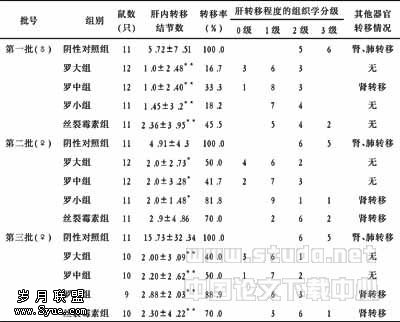rhG-CSF动员的儿童自体外周血干细胞冻存后回输的毒副作用研究
作者:王建文 唐锁勤 吕善根 冉崇容 扬光 刘英 高晓宁
【摘要】 本研究探讨儿童患者中冻存自体外周血造血干细胞回输的相关毒性。对35例恶性肿瘤患儿经大剂量化疗或大剂量化疗加放疗的预处理后,进行解冻后的冻存自体外周血造血干细胞分次快速回输,对70例次输注进行了毒性评定。全部病人采用化疗加重组人粒细胞刺激因子(rhG?CSF)进行动员,以CS?3000 plus型 或COBE spectra?4型血细胞分离机采集外周血造血干细胞。移植物置于10%二甲亚砜(DMSO)中冷冻,并保存在液氮中。 35例恶性肿瘤患儿输注总量190-420 ml(265±73 ml,相当于13.7±4.2 ml/kg),含干细胞数(4.43±1.91)×108/kg, DMSO平均输注总量0.94±0.18 g/kg。单次输注量90-300 ml(132±37 ml,相当于6.6±5.2 ml/kg),DMSO 0.68±0.12 g/kg,同时观察并记录输注过程中出现的症状, 并监测输注后24小时内脉搏、血压、体温、呼吸频率,每15分钟记录1次。输注前、后检测血清钾、钠、肌酐、总胆红素、天门冬氨酸转移酶和丙氨酸转移酶及尿液检测。结果表明: 回输后出现轻微相关毒性,诸如血红蛋白尿(77.1%)、头痛(40.0%)、恶心(34.3%)、呕吐(24.3%)、腹痛(11.4%)、心动过速(10.0%)、心动过缓(5.7%),但无休克等严重毒性反应。血胆红素在输注后有所升高。输注量>200 ml的患者,其血红蛋白尿、头痛、恶心、呕吐和腹痛的发生率有升高趋势(P<0.01),仍可迅速消失。首次输注后总胆红素有升高(P<0.01),并观察到输注后胆红素升高程度与输注量明显相关(r=0.8977, P<0.01)。结论: 冻存的儿童自体外周血造血干细胞分次回输的相关毒副作用较轻,发生率较低,头痛、恶心、呕吐的发生率与单次回输量有关。
【关键词】 自体造血干细胞移植 rhG?CSF动员; 自体外周血造血干细胞回输; 儿童血液病
Relevant Low Toxicities with rhG?CSF Mobilized and Cryopre?served Autologous Peripheral Blood Stem Cell Return Infusions in Children
Abstract The purpose of this study was to evaluate the safety of cryopreserved and thawed peripheral blood stem cell (PBSC) fractionated return infusions in children. 35 chilood patients with malignant tumors (13 acute leukaemias, 15 neuroblastomas and 7 malignant lymphomas) received fractionated return infusions of cryopreserved stem cells after undergoing high?dose chemotherapy without or with total body irradiation. The toxicities of 70 return infusions were evaluated. All patients were mobilized by chemotherapy plus recombination human granulocyte colony?stimulating factor (rhG?CSF), and then PBSCs were collected by a separator CS?3000 plus or COBE spectra?4. The grafts were cryopreserved in 10% dimethyl sulfoxide(DMSD) and stored in liquid nitrogen. There were totally 70 PBSC transfusions. The total volume of PBSCs transfused: 190-420 ml (265±73 ml or 13.7±4.2 ml/kg) with a mean of (4.43±1.91)×108/kg of PBSCs, and 0.94±0.18 g/kg of DMSO. The single dose: 90-300 ml(132±37 ml or 6.6±5.2 ml/kg)with a mean of 0.68±0.12 g/kg of DMSO. Symptoms occurring during the infusions were recorded. All patients were monitored for 24 hours after infusion. Pulse, blood pressure, body temperature, and respiratory rate were recorded every 15 minutes. At four hours before and 8 hours after infusion, urinalysis was performed. Serum potassium, sodium, creatinine, total bilirubin, aspartate amino transferase (AST), and alanine amino transferase (ALT) levels were examined within 24 hours before and after the first infusion. The results showed that the toxicities observed included hemoglobinuria in 54 retun infusions (77.1%), headache in 28 (40.0%), nausea in 24 (34.3%), vomiting in 17 (24.3%), and abdominal pain in 8 (11.4%). Patients who received a graft >200 ml tended to have a higher frequency of hemoglobinuria, headache, nausea, vomiting, or abdominal pain (P<0.01), and they disappeared quickly, too. Total bilirubin increased after the first return infusion (P<0.01), and there was a significant correlation between the volume of infusion and the degree of total bilirubin increase (r=0.8977, P<0.01). No renal failure or shock occurred. It is concluded that transient hemoglobinuria, headache, nausea, vomiting, and abdominal pain are common toxicities associated with PBSC autograft, and these toxicities are related with a single volume of PBSCs transfused. Total bilirubin increase is correlated with the volume of infusion. In a word, the toxicity is less frequent and lower severe in children with fractionated infusions of cryopreserved peripheral blood stem cell.
Key words autologous peripheral blood stem cell transplantation; rhG?CSF mobilization; autologous peripheral blood stem cell return infusion; pediatric hematologic malignancy
J Exp Hematol 2007; 15(2):404-407
实验血液学杂志 J Exp Hematol 2007; 15(2)rhG?CSF动员的儿童自体外周血干细胞冻存后回输相关低毒性临床研究 在恶性肿瘤的中,化疗是重要而有效的方法之一,但是常规化疗对于难治性恶性肿瘤往往效果不佳。造血干细胞移植技术的出现使大剂量化疗得以进行,并取得了令人瞩目的效果。由于自体干细胞需要进行体外低温保存,因此回输后会发生相关毒性反应。我科开展了儿童自体外周血造血干细胞移植治疗恶性肿瘤,已完成35例,现就其回输的相关毒性如下。
材料和方法
一般资料
共35例患儿,男22例,女13例,平均年龄6.9(3-13)岁,体重18.5(15-48)公斤,全部病例均经组织学诊断确诊。病种包括急性白血病13例,恶性淋巴瘤7例,神经母细胞瘤15例。
干细胞动员、采集与冻存
于移植前1-3个月进行干细胞动员和采集。动员方案为化疗加人重组粒细胞集落刺激因子(rhG?CSF),剂量5-10 μg/(kg·d)。用CS?3000 plus和COBE spectra? 4型血细胞分离机采集2-3次,采集单个核细胞(MNC)(6.26±2.73)(3.44-11.19)×108/kg ,CD34+细胞(9.18± 5.65) (3.35-16.83)×106/kg,CFU?GM集落(16.14±14.47)(1.67-34.15)×104/kg。患儿体重低于20 kg时,在采集前以经照射的红细胞悬液进行预充。每次采集后,将干细胞加入RPMI 1640液,以二甲亚砜(DMSO)为细胞保护剂,终浓度为: DMSO 10%和(5-10)×1010/L的细胞浓度,细胞液分装于冷藏袋内。用速率控制降温仪冷冻细胞,采集物置于-196℃液氮进行冻存。
预处理方案
对于全身照射的19例患者,其预处理基本方案为环磷酰胺加分次全身照射(FTBI)。环磷酰胺剂量为50 mg/kg×2次,FTBI剂量为6.5-8 Gy,分2次照射,剂量率≤5 cGy/min。此外,联合应用的药物包括有:阿糖胞苷1-2 g/m2,1-3次;足叶乙甙100-300 mg/m2,2-3次;甲环亚硝脲150-250 mg/m2,1次。对于不含全身照射的16例患者,其预处理基本方案为卡铂425 mg/(m2·d)与足叶乙甙338 mg/(m2·d),于回输前7、6、5、4天进行24小时持续静脉滴注,马法兰70 mg/(m2· d),于回输前7、6、5天静脉注射;或白消胺1 mg/(kg· 6h),于回输前6、5、4天口服, 马法兰140 mg/m2 ,于回输前3天静脉注射。
干细胞回输
于预处理结束之后48-72小时,将冷冻的PBSC分2次于40℃水浴迅速解冻,然后经中心静脉回输,回输物不经洗涤。回输前以3 000 ml/m2的液体量水化,并于回输前15分钟静脉注射地塞米松2 mg。多数病人分2次接受干细胞回输,每次回输于30分钟以内完成。平均回输总量为265±73 ml(190-420 ml,约相当于13.7±4.2 ml/kg),含单个核细胞(4.43±1.91)×108/kg,DMSO量为0.94±0.18 g/kg。平均单次回输量为132±37 ml(90-300 ml,约相当于6.6±5.2 ml/kg), DMSO量为0.68±0.12 g/kg。
病人监测
回输前对患儿进行相关检查,包括尿常规和血生化指标,以及体温、血压、呼吸、心率。回输后4、8、12小时查尿常规指标,12、24小时查血生化指标,回输期间和回输后24小时内严密观察患儿临床反应。同时监测生命体征,15分钟测量1次体温、血压、呼吸、心率,至回输后2小时。
统计学处理
相关毒性临床反应进行χ2检验,血生化指标进行配对t检验并做相关性分析。
结 果
回输相关临床反应
35例患儿共接受冻存自体造血干细胞回输70次,相关的毒性反应以血红蛋白尿、头痛、恶心、呕吐发生率较高。无心脏、肝、肾功能衰竭及休克等严重反应(表1)。对35例次接受首次输注前后的生化指标进行了比较,结果见表2。由表2可见,总胆红素在冻存自体造血干细胞回输后有显著变化(t=12.468, P<0.01)。血胆红素升高程度与输注量呈高度相关(确定系数RR=0.877, r=0.8977, P<0.01)(附图)。
讨 论
随着自体造血干细胞移植的广泛应用,对与其相关的毒副反应也有了认识,冻存干细胞解冻后回输出现相关毒性反应已有报道[1]。目前认为,其机制与冻存和解冻过程中的红细胞裂解,以及冻存物中添加的DMSO有关[2,3]。红细胞裂解物引起发热、高血钾并损伤肾小管,进而影响肾功能。红细胞裂解物还会刺激内皮细胞释放活性因子,启动凝血系统,引起血管内凝血、休克。DMSO作为细胞保护剂有着良好效果[4],但同时有促进组织胺释放的作用,导致相应症状的出现,表现为面部潮红、头痛、恶心、呕吐、腹痛及血压异常,并且发生率与剂量相关。
由本组病例的临床表现看,血红蛋白尿、头痛、腹痛、恶心、呕吐和心动过速发生率高。血红蛋白尿发生与回输物中存在的红细胞裂解物有关,有引起急性肾功能衰竭的危险。我们采用水化、碱化和利尿措施,于12小时内尿液均恢复正常,没有发生急性肾功能受损情况。临床反应的发生率、严重程度与单次回输量、回输速度有关[5,6]。头痛、腹痛、恶心、呕吐与回输物中的DMSO有关,表现为一过性。当单次回输量超过200 ml时(共18例次)上述症状的发生率明显上升。心脏毒性表现为心率的变化,4例次心率减慢,并且输注速度加快心率减慢加剧,减慢输注速度后心率恢复正常。7例次心动过速。1例患儿一次性输入300 ml发生了剧烈头痛,血压下降、心率减慢明显,经对症后缓解。考虑到首次回输对血清生化指标的影响,故仅对首次回输(35例次)前后血清生化指标进行比较,结果提示胆红素在回输后升高,且升高程度与回输量相关,这可能与回输物中细胞裂解产物有关。另外,血钾也有所升高,可能与部分病例水化液中加入氯化钾注射液有关。
针对回输物中的细胞裂解物和DMSO,有人在回输前用洗涤的方法试图祛除它们,以减少回输的相关反应。但是,这种方法会损失干细胞数量,有造成移植失败的危险[7],为了降低这一危险势必要增加采集的干细胞数量,加重病人治疗的负担。因此,我们没有采用洗涤的方法。鉴于回输的毒副反应与单次回输量关系密切,而采用了分次回输,结果副作用较轻微,总体发生率较相关报道低[8],并且是可逆的。
另外,回输的相关副作用还与其他多种因素有关,特别是移植前的治疗。我们观察到心动过速的发生率较高[8],并且多发生于前期治疗应用蒽环类药物较多的病例,这可能与此类药物的心脏毒性有关[9]。有人认为,自体外周血干细胞移植有可能发生与rhG?CSF相关的植入综合征,表现为发热、皮疹和肝肾功能受损[10]。本组病例所采用的干细胞动员方案包含了rhG?CSF,但由于采取了皮下注射的方式,并且采集量少,故回输物中rhG?CSF的含量不会引起植入综合征,与回输的相关毒性关系不大。
有人采用羟基淀粉加DMSO来保存采集的干细胞以减少DMSO的用量[11],相信随着各种治疗手段的,干细胞采集和储存技术的进步,干细胞的纯度会更高,回输的相关毒副作用势必会减少。
【】
1Davis JM, Rowley SD, Braine HG,et al. Clinical toxicity of cryopreserved bone marrow graft infusion. Blood, 1990;75:781-786
2Cregan P, Donegan E,Gotelli G,et al. Hemolytic transfusion reaction following transfusion of frozen and washed autologous red cells.Transfusion,1991;31:172-175
3Stroneck DF,Fautsch SK,Lasky LC,et al. Adverse reactions in patients transfused with cryopreserved marrow.Transfusion, 1991;31:521-526
4Attarian H, Feng Z, Buckner CD, et al. Long?term cryopreservation of bone marrow for autologous transplantation. Bone Marrow Transplant, 1996; 17:425-430
5Martino M, Morabito F, Messina G, et al. Fractionated infusions of cryopreserved stem cells may prevent DMSO?induced major cardiac complications in graft recipients. Haematologica, 1996; 81:59-61
6Lopez?Jimenez J, Cervero C, Munoz A, et al. Cardiovascular toxicities related to the infusion of cryopreserved grafts: results of a controlled study. Bone Marrow Transplant, 1994; 13:789-793
7Syme R, Bewick M, Stewart D, et al.The role of depletion of dimethyl sulfoxide before autografting: on hematologic recovery, side effects, and toxicity. Biol Blood Marrow Transplant, 2004; 10:135-141
8Okamoto Y, Takaue Y, Saito S, et al. Toxicities associated with cryopreserved and thawed peripheral blood stem cell autografts in children with active cancer. Transfusion, 1993; 33:578-581
9Nysom K, Holm K, Lipsitz SR, et al. Relationship between cumulative anthracycline dose and late cardiotoxicity in childhood acute lymphoblastic leukemia. J Clin Oncol, 1998;16:545-550
10Madero L, Vicent MG, Sevilla J, et al. Engraftment syndrome in children undergoing autologous peripheral blood progenitor cell transplantation. Bone Marrow Transplant, 2002 ; 30:355-358
11Maruyama M, Kenmochi T, Sakamoto K, et al. Simplified method for cryopreservation of islets using hydroxyethyl starch and dimethyl sulfoxide as cryoprotectants. Transplant Proc, 2004; 36:1133-1134











